Analysis of International Business Strategy and Entry Modes
VerifiedAdded on 2020/12/29
|11
|4090
|218
Report
AI Summary
This report provides an overview of international business strategy, with a specific focus on the Uppsala Internationalization Model. The report explains the model's core concepts, including the stages of internationalization, the role of psychic distance, and the importance of market knowledge and commitment. It further explores various foreign market entry modes, such as exporting, licensing, franchising, and joint ventures, analyzing their characteristics, advantages, and disadvantages. The report highlights the incremental nature of internationalization as proposed by the Uppsala model and discusses the factors influencing firms' decisions to commit resources and engage in foreign activities. The analysis emphasizes the importance of experience, knowledge, and risk assessment in the internationalization process, providing a comprehensive understanding of the strategic considerations involved in expanding a business globally.
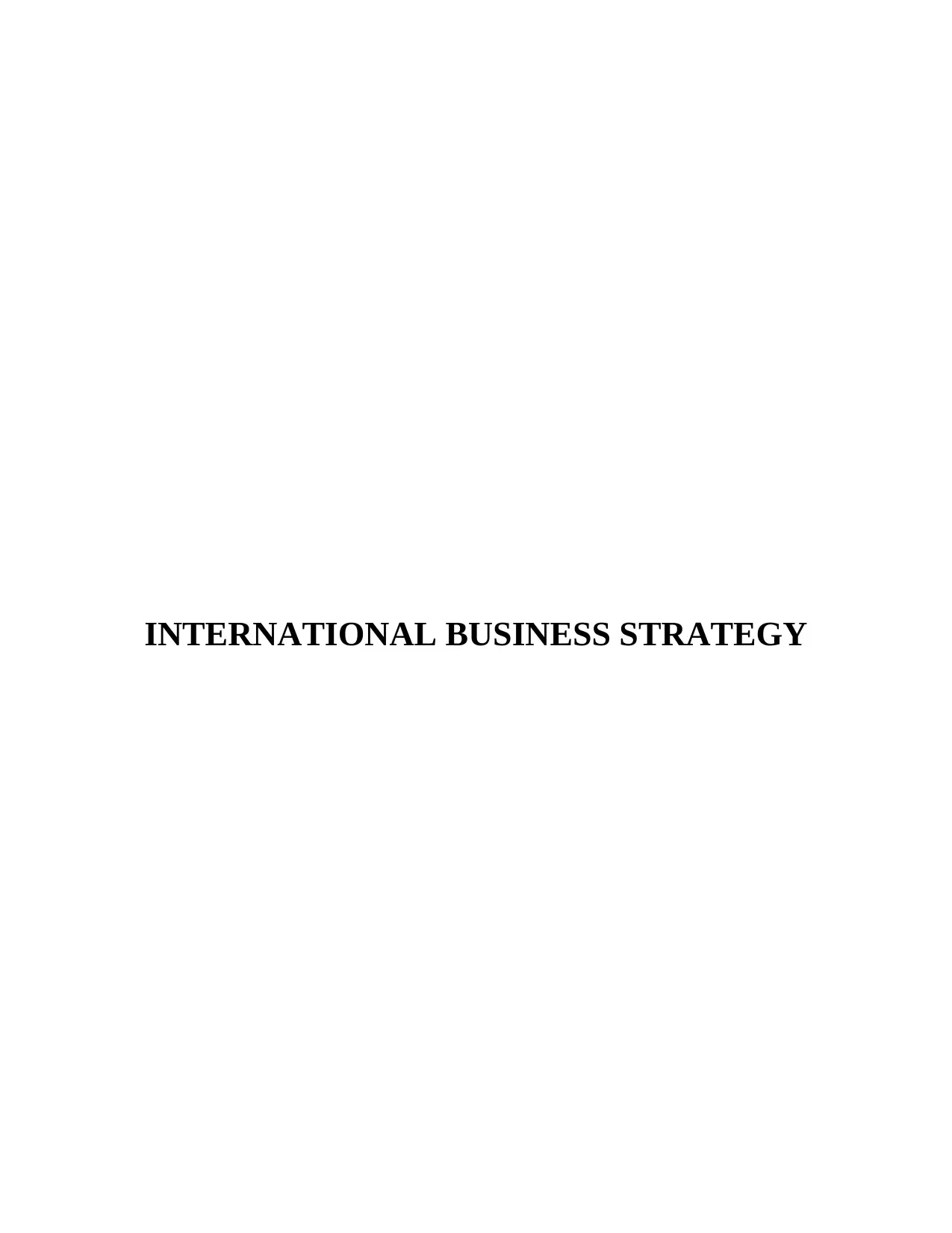
INTERNATIONAL BUSINESS STRATEGY
Paraphrase This Document
Need a fresh take? Get an instant paraphrase of this document with our AI Paraphraser
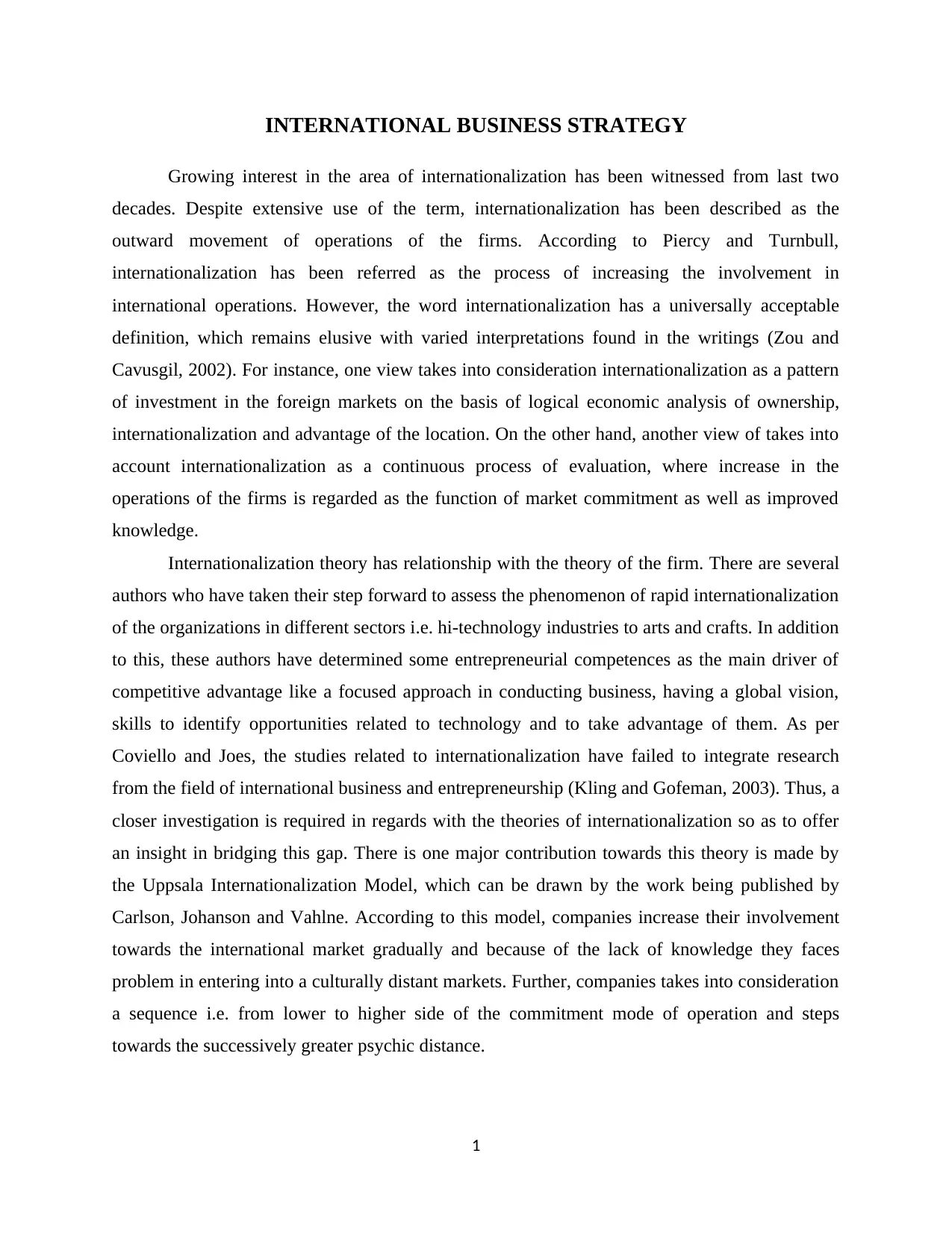
INTERNATIONAL BUSINESS STRATEGY
Growing interest in the area of internationalization has been witnessed from last two
decades. Despite extensive use of the term, internationalization has been described as the
outward movement of operations of the firms. According to Piercy and Turnbull,
internationalization has been referred as the process of increasing the involvement in
international operations. However, the word internationalization has a universally acceptable
definition, which remains elusive with varied interpretations found in the writings (Zou and
Cavusgil, 2002). For instance, one view takes into consideration internationalization as a pattern
of investment in the foreign markets on the basis of logical economic analysis of ownership,
internationalization and advantage of the location. On the other hand, another view of takes into
account internationalization as a continuous process of evaluation, where increase in the
operations of the firms is regarded as the function of market commitment as well as improved
knowledge.
Internationalization theory has relationship with the theory of the firm. There are several
authors who have taken their step forward to assess the phenomenon of rapid internationalization
of the organizations in different sectors i.e. hi-technology industries to arts and crafts. In addition
to this, these authors have determined some entrepreneurial competences as the main driver of
competitive advantage like a focused approach in conducting business, having a global vision,
skills to identify opportunities related to technology and to take advantage of them. As per
Coviello and Joes, the studies related to internationalization have failed to integrate research
from the field of international business and entrepreneurship (Kling and Gofeman, 2003). Thus, a
closer investigation is required in regards with the theories of internationalization so as to offer
an insight in bridging this gap. There is one major contribution towards this theory is made by
the Uppsala Internationalization Model, which can be drawn by the work being published by
Carlson, Johanson and Vahlne. According to this model, companies increase their involvement
towards the international market gradually and because of the lack of knowledge they faces
problem in entering into a culturally distant markets. Further, companies takes into consideration
a sequence i.e. from lower to higher side of the commitment mode of operation and steps
towards the successively greater psychic distance.
1
Growing interest in the area of internationalization has been witnessed from last two
decades. Despite extensive use of the term, internationalization has been described as the
outward movement of operations of the firms. According to Piercy and Turnbull,
internationalization has been referred as the process of increasing the involvement in
international operations. However, the word internationalization has a universally acceptable
definition, which remains elusive with varied interpretations found in the writings (Zou and
Cavusgil, 2002). For instance, one view takes into consideration internationalization as a pattern
of investment in the foreign markets on the basis of logical economic analysis of ownership,
internationalization and advantage of the location. On the other hand, another view of takes into
account internationalization as a continuous process of evaluation, where increase in the
operations of the firms is regarded as the function of market commitment as well as improved
knowledge.
Internationalization theory has relationship with the theory of the firm. There are several
authors who have taken their step forward to assess the phenomenon of rapid internationalization
of the organizations in different sectors i.e. hi-technology industries to arts and crafts. In addition
to this, these authors have determined some entrepreneurial competences as the main driver of
competitive advantage like a focused approach in conducting business, having a global vision,
skills to identify opportunities related to technology and to take advantage of them. As per
Coviello and Joes, the studies related to internationalization have failed to integrate research
from the field of international business and entrepreneurship (Kling and Gofeman, 2003). Thus, a
closer investigation is required in regards with the theories of internationalization so as to offer
an insight in bridging this gap. There is one major contribution towards this theory is made by
the Uppsala Internationalization Model, which can be drawn by the work being published by
Carlson, Johanson and Vahlne. According to this model, companies increase their involvement
towards the international market gradually and because of the lack of knowledge they faces
problem in entering into a culturally distant markets. Further, companies takes into consideration
a sequence i.e. from lower to higher side of the commitment mode of operation and steps
towards the successively greater psychic distance.
1
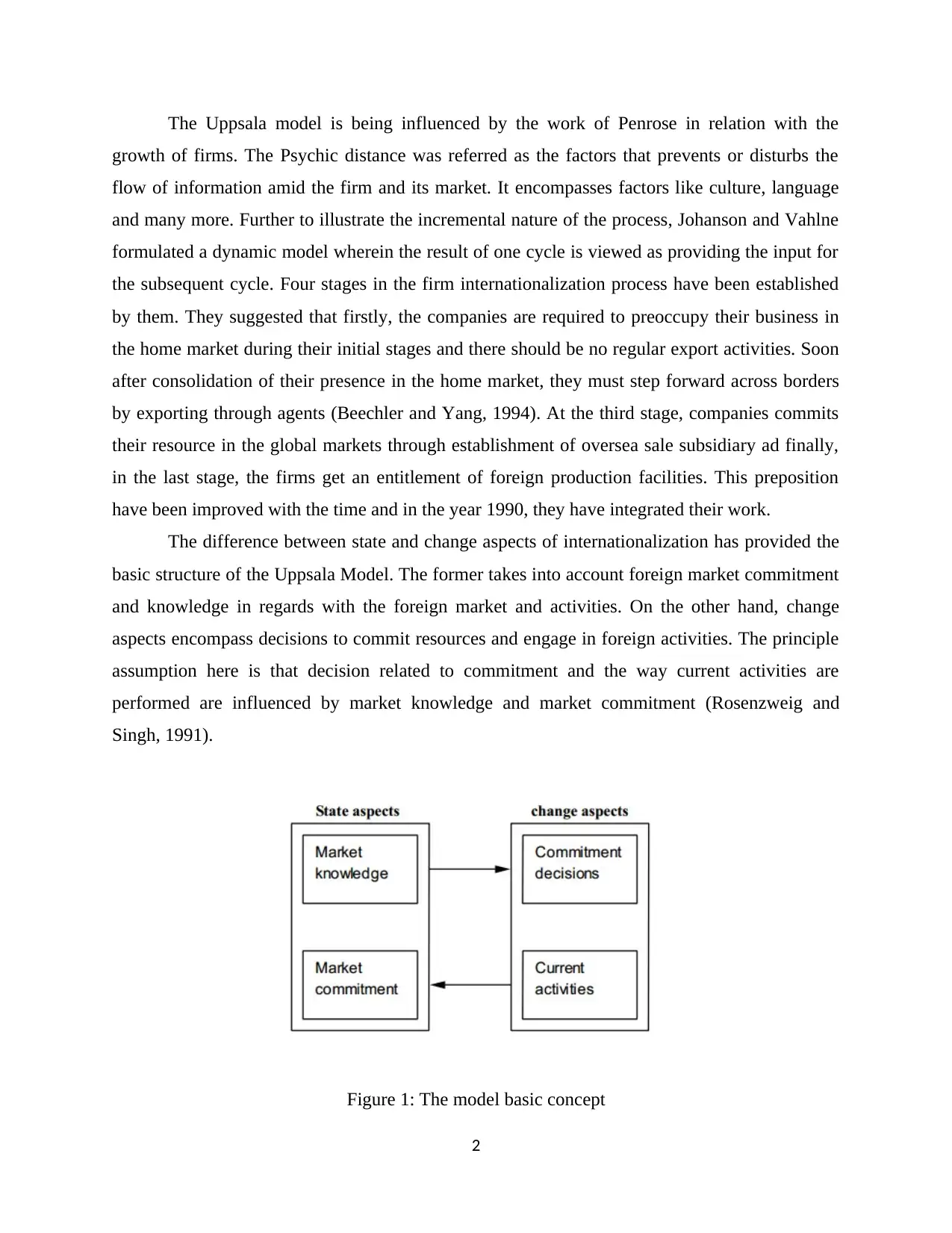
The Uppsala model is being influenced by the work of Penrose in relation with the
growth of firms. The Psychic distance was referred as the factors that prevents or disturbs the
flow of information amid the firm and its market. It encompasses factors like culture, language
and many more. Further to illustrate the incremental nature of the process, Johanson and Vahlne
formulated a dynamic model wherein the result of one cycle is viewed as providing the input for
the subsequent cycle. Four stages in the firm internationalization process have been established
by them. They suggested that firstly, the companies are required to preoccupy their business in
the home market during their initial stages and there should be no regular export activities. Soon
after consolidation of their presence in the home market, they must step forward across borders
by exporting through agents (Beechler and Yang, 1994). At the third stage, companies commits
their resource in the global markets through establishment of oversea sale subsidiary ad finally,
in the last stage, the firms get an entitlement of foreign production facilities. This preposition
have been improved with the time and in the year 1990, they have integrated their work.
The difference between state and change aspects of internationalization has provided the
basic structure of the Uppsala Model. The former takes into account foreign market commitment
and knowledge in regards with the foreign market and activities. On the other hand, change
aspects encompass decisions to commit resources and engage in foreign activities. The principle
assumption here is that decision related to commitment and the way current activities are
performed are influenced by market knowledge and market commitment (Rosenzweig and
Singh, 1991).
Figure 1: The model basic concept
2
growth of firms. The Psychic distance was referred as the factors that prevents or disturbs the
flow of information amid the firm and its market. It encompasses factors like culture, language
and many more. Further to illustrate the incremental nature of the process, Johanson and Vahlne
formulated a dynamic model wherein the result of one cycle is viewed as providing the input for
the subsequent cycle. Four stages in the firm internationalization process have been established
by them. They suggested that firstly, the companies are required to preoccupy their business in
the home market during their initial stages and there should be no regular export activities. Soon
after consolidation of their presence in the home market, they must step forward across borders
by exporting through agents (Beechler and Yang, 1994). At the third stage, companies commits
their resource in the global markets through establishment of oversea sale subsidiary ad finally,
in the last stage, the firms get an entitlement of foreign production facilities. This preposition
have been improved with the time and in the year 1990, they have integrated their work.
The difference between state and change aspects of internationalization has provided the
basic structure of the Uppsala Model. The former takes into account foreign market commitment
and knowledge in regards with the foreign market and activities. On the other hand, change
aspects encompass decisions to commit resources and engage in foreign activities. The principle
assumption here is that decision related to commitment and the way current activities are
performed are influenced by market knowledge and market commitment (Rosenzweig and
Singh, 1991).
Figure 1: The model basic concept
2
⊘ This is a preview!⊘
Do you want full access?
Subscribe today to unlock all pages.

Trusted by 1+ million students worldwide
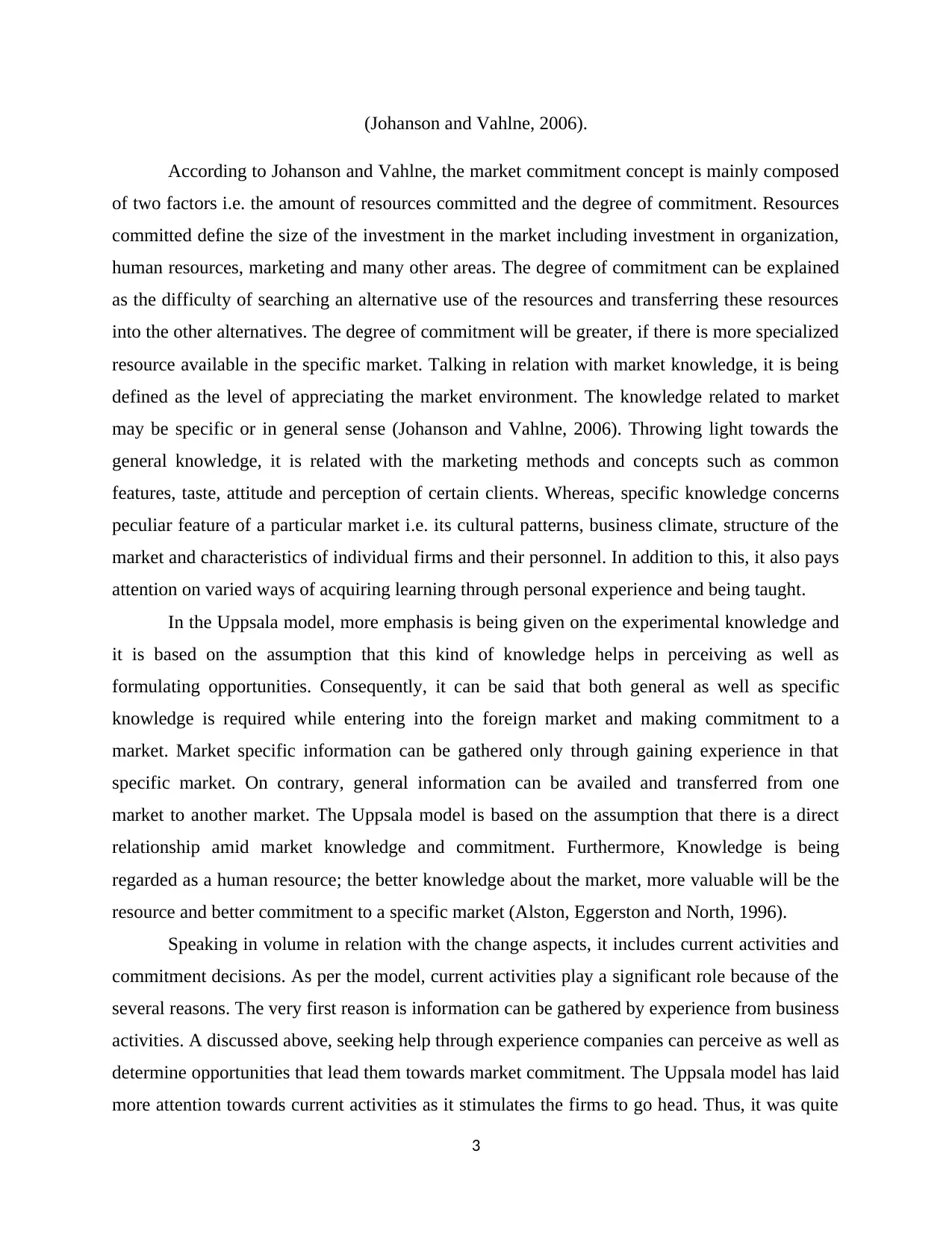
(Johanson and Vahlne, 2006).
According to Johanson and Vahlne, the market commitment concept is mainly composed
of two factors i.e. the amount of resources committed and the degree of commitment. Resources
committed define the size of the investment in the market including investment in organization,
human resources, marketing and many other areas. The degree of commitment can be explained
as the difficulty of searching an alternative use of the resources and transferring these resources
into the other alternatives. The degree of commitment will be greater, if there is more specialized
resource available in the specific market. Talking in relation with market knowledge, it is being
defined as the level of appreciating the market environment. The knowledge related to market
may be specific or in general sense (Johanson and Vahlne, 2006). Throwing light towards the
general knowledge, it is related with the marketing methods and concepts such as common
features, taste, attitude and perception of certain clients. Whereas, specific knowledge concerns
peculiar feature of a particular market i.e. its cultural patterns, business climate, structure of the
market and characteristics of individual firms and their personnel. In addition to this, it also pays
attention on varied ways of acquiring learning through personal experience and being taught.
In the Uppsala model, more emphasis is being given on the experimental knowledge and
it is based on the assumption that this kind of knowledge helps in perceiving as well as
formulating opportunities. Consequently, it can be said that both general as well as specific
knowledge is required while entering into the foreign market and making commitment to a
market. Market specific information can be gathered only through gaining experience in that
specific market. On contrary, general information can be availed and transferred from one
market to another market. The Uppsala model is based on the assumption that there is a direct
relationship amid market knowledge and commitment. Furthermore, Knowledge is being
regarded as a human resource; the better knowledge about the market, more valuable will be the
resource and better commitment to a specific market (Alston, Eggerston and North, 1996).
Speaking in volume in relation with the change aspects, it includes current activities and
commitment decisions. As per the model, current activities play a significant role because of the
several reasons. The very first reason is information can be gathered by experience from business
activities. A discussed above, seeking help through experience companies can perceive as well as
determine opportunities that lead them towards market commitment. The Uppsala model has laid
more attention towards current activities as it stimulates the firms to go head. Thus, it was quite
3
According to Johanson and Vahlne, the market commitment concept is mainly composed
of two factors i.e. the amount of resources committed and the degree of commitment. Resources
committed define the size of the investment in the market including investment in organization,
human resources, marketing and many other areas. The degree of commitment can be explained
as the difficulty of searching an alternative use of the resources and transferring these resources
into the other alternatives. The degree of commitment will be greater, if there is more specialized
resource available in the specific market. Talking in relation with market knowledge, it is being
defined as the level of appreciating the market environment. The knowledge related to market
may be specific or in general sense (Johanson and Vahlne, 2006). Throwing light towards the
general knowledge, it is related with the marketing methods and concepts such as common
features, taste, attitude and perception of certain clients. Whereas, specific knowledge concerns
peculiar feature of a particular market i.e. its cultural patterns, business climate, structure of the
market and characteristics of individual firms and their personnel. In addition to this, it also pays
attention on varied ways of acquiring learning through personal experience and being taught.
In the Uppsala model, more emphasis is being given on the experimental knowledge and
it is based on the assumption that this kind of knowledge helps in perceiving as well as
formulating opportunities. Consequently, it can be said that both general as well as specific
knowledge is required while entering into the foreign market and making commitment to a
market. Market specific information can be gathered only through gaining experience in that
specific market. On contrary, general information can be availed and transferred from one
market to another market. The Uppsala model is based on the assumption that there is a direct
relationship amid market knowledge and commitment. Furthermore, Knowledge is being
regarded as a human resource; the better knowledge about the market, more valuable will be the
resource and better commitment to a specific market (Alston, Eggerston and North, 1996).
Speaking in volume in relation with the change aspects, it includes current activities and
commitment decisions. As per the model, current activities play a significant role because of the
several reasons. The very first reason is information can be gathered by experience from business
activities. A discussed above, seeking help through experience companies can perceive as well as
determine opportunities that lead them towards market commitment. The Uppsala model has laid
more attention towards current activities as it stimulates the firms to go head. Thus, it was quite
3
Paraphrase This Document
Need a fresh take? Get an instant paraphrase of this document with our AI Paraphraser
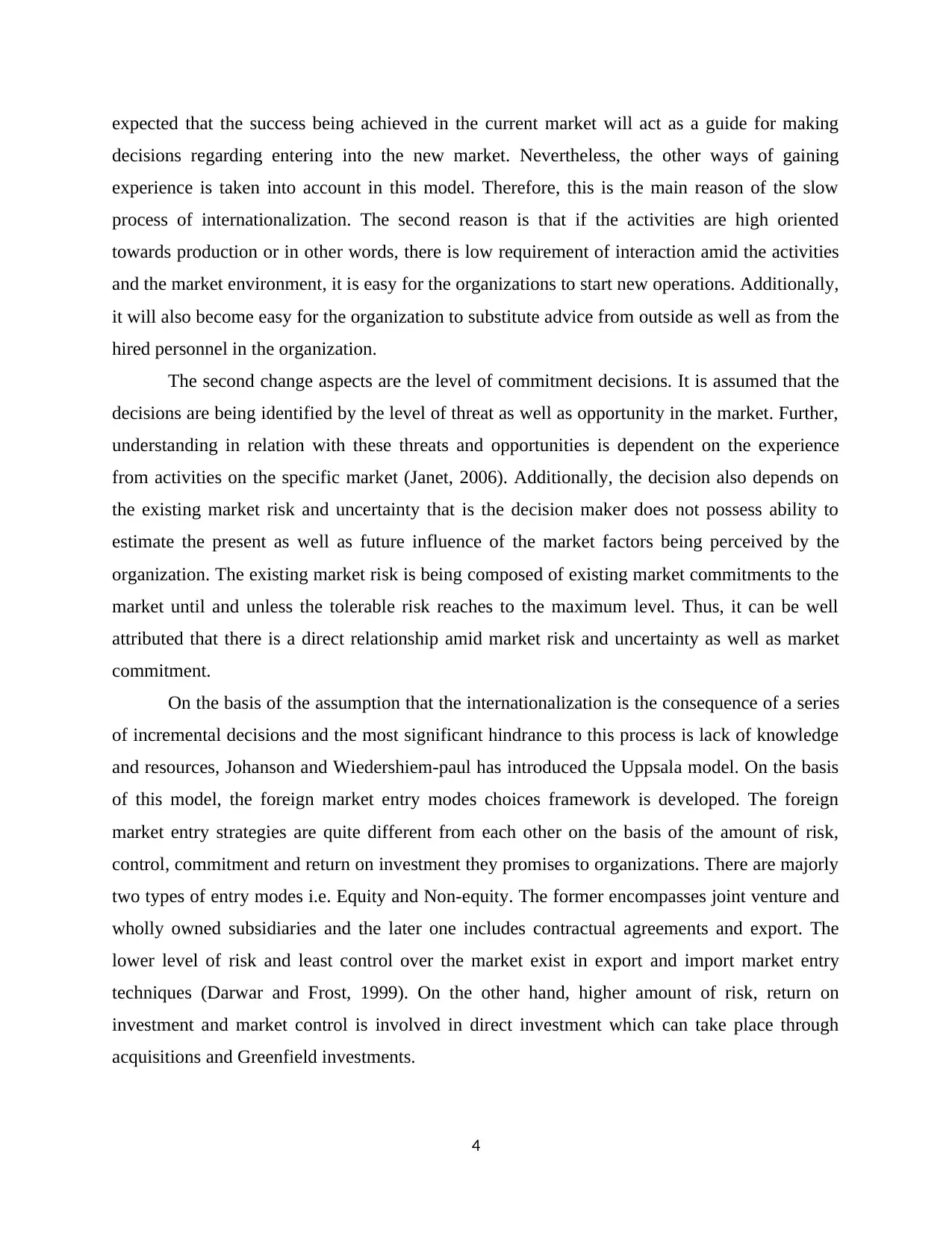
expected that the success being achieved in the current market will act as a guide for making
decisions regarding entering into the new market. Nevertheless, the other ways of gaining
experience is taken into account in this model. Therefore, this is the main reason of the slow
process of internationalization. The second reason is that if the activities are high oriented
towards production or in other words, there is low requirement of interaction amid the activities
and the market environment, it is easy for the organizations to start new operations. Additionally,
it will also become easy for the organization to substitute advice from outside as well as from the
hired personnel in the organization.
The second change aspects are the level of commitment decisions. It is assumed that the
decisions are being identified by the level of threat as well as opportunity in the market. Further,
understanding in relation with these threats and opportunities is dependent on the experience
from activities on the specific market (Janet, 2006). Additionally, the decision also depends on
the existing market risk and uncertainty that is the decision maker does not possess ability to
estimate the present as well as future influence of the market factors being perceived by the
organization. The existing market risk is being composed of existing market commitments to the
market until and unless the tolerable risk reaches to the maximum level. Thus, it can be well
attributed that there is a direct relationship amid market risk and uncertainty as well as market
commitment.
On the basis of the assumption that the internationalization is the consequence of a series
of incremental decisions and the most significant hindrance to this process is lack of knowledge
and resources, Johanson and Wiedershiem-paul has introduced the Uppsala model. On the basis
of this model, the foreign market entry modes choices framework is developed. The foreign
market entry strategies are quite different from each other on the basis of the amount of risk,
control, commitment and return on investment they promises to organizations. There are majorly
two types of entry modes i.e. Equity and Non-equity. The former encompasses joint venture and
wholly owned subsidiaries and the later one includes contractual agreements and export. The
lower level of risk and least control over the market exist in export and import market entry
techniques (Darwar and Frost, 1999). On the other hand, higher amount of risk, return on
investment and market control is involved in direct investment which can take place through
acquisitions and Greenfield investments.
4
decisions regarding entering into the new market. Nevertheless, the other ways of gaining
experience is taken into account in this model. Therefore, this is the main reason of the slow
process of internationalization. The second reason is that if the activities are high oriented
towards production or in other words, there is low requirement of interaction amid the activities
and the market environment, it is easy for the organizations to start new operations. Additionally,
it will also become easy for the organization to substitute advice from outside as well as from the
hired personnel in the organization.
The second change aspects are the level of commitment decisions. It is assumed that the
decisions are being identified by the level of threat as well as opportunity in the market. Further,
understanding in relation with these threats and opportunities is dependent on the experience
from activities on the specific market (Janet, 2006). Additionally, the decision also depends on
the existing market risk and uncertainty that is the decision maker does not possess ability to
estimate the present as well as future influence of the market factors being perceived by the
organization. The existing market risk is being composed of existing market commitments to the
market until and unless the tolerable risk reaches to the maximum level. Thus, it can be well
attributed that there is a direct relationship amid market risk and uncertainty as well as market
commitment.
On the basis of the assumption that the internationalization is the consequence of a series
of incremental decisions and the most significant hindrance to this process is lack of knowledge
and resources, Johanson and Wiedershiem-paul has introduced the Uppsala model. On the basis
of this model, the foreign market entry modes choices framework is developed. The foreign
market entry strategies are quite different from each other on the basis of the amount of risk,
control, commitment and return on investment they promises to organizations. There are majorly
two types of entry modes i.e. Equity and Non-equity. The former encompasses joint venture and
wholly owned subsidiaries and the later one includes contractual agreements and export. The
lower level of risk and least control over the market exist in export and import market entry
techniques (Darwar and Frost, 1999). On the other hand, higher amount of risk, return on
investment and market control is involved in direct investment which can take place through
acquisitions and Greenfield investments.
4
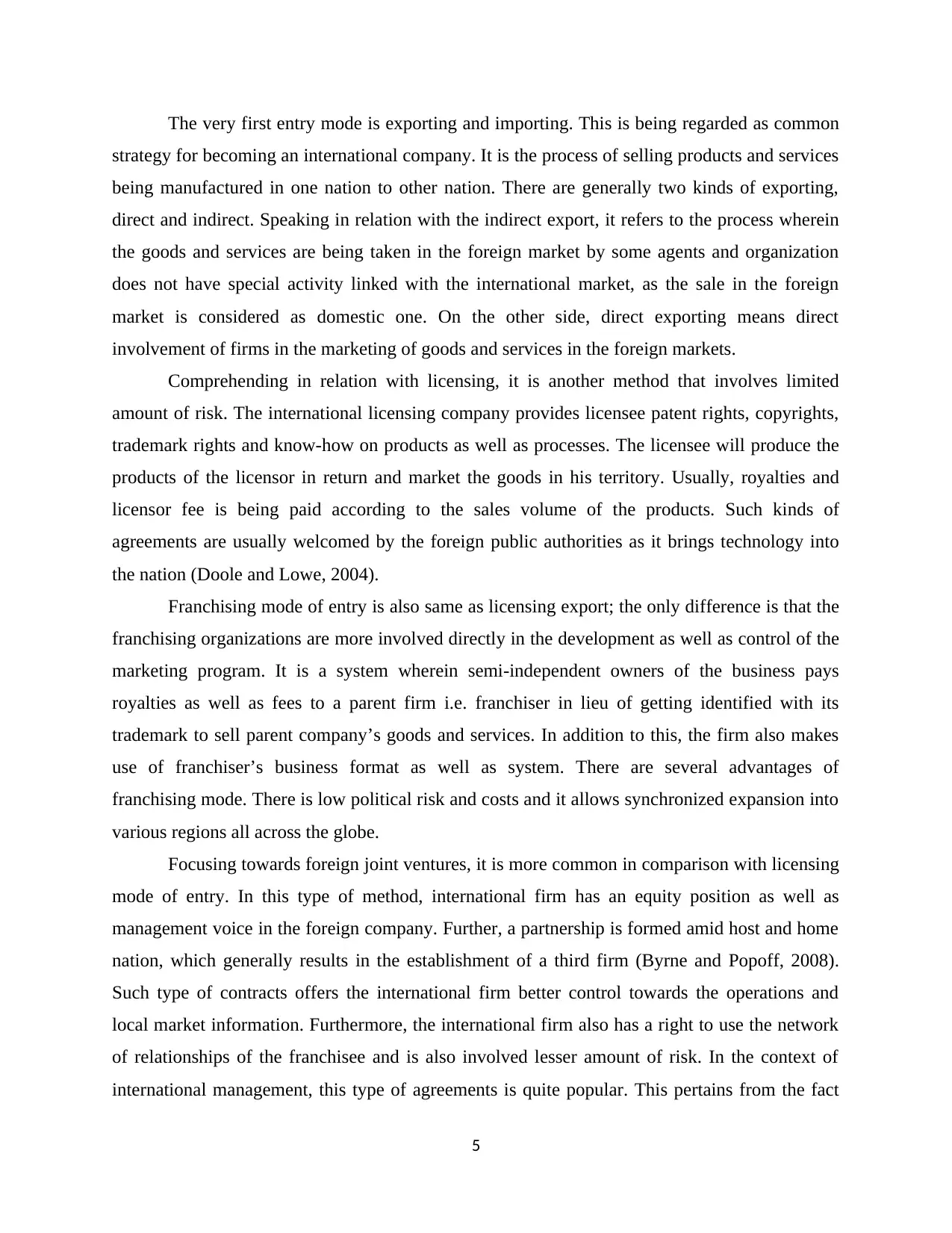
The very first entry mode is exporting and importing. This is being regarded as common
strategy for becoming an international company. It is the process of selling products and services
being manufactured in one nation to other nation. There are generally two kinds of exporting,
direct and indirect. Speaking in relation with the indirect export, it refers to the process wherein
the goods and services are being taken in the foreign market by some agents and organization
does not have special activity linked with the international market, as the sale in the foreign
market is considered as domestic one. On the other side, direct exporting means direct
involvement of firms in the marketing of goods and services in the foreign markets.
Comprehending in relation with licensing, it is another method that involves limited
amount of risk. The international licensing company provides licensee patent rights, copyrights,
trademark rights and know-how on products as well as processes. The licensee will produce the
products of the licensor in return and market the goods in his territory. Usually, royalties and
licensor fee is being paid according to the sales volume of the products. Such kinds of
agreements are usually welcomed by the foreign public authorities as it brings technology into
the nation (Doole and Lowe, 2004).
Franchising mode of entry is also same as licensing export; the only difference is that the
franchising organizations are more involved directly in the development as well as control of the
marketing program. It is a system wherein semi-independent owners of the business pays
royalties as well as fees to a parent firm i.e. franchiser in lieu of getting identified with its
trademark to sell parent company’s goods and services. In addition to this, the firm also makes
use of franchiser’s business format as well as system. There are several advantages of
franchising mode. There is low political risk and costs and it allows synchronized expansion into
various regions all across the globe.
Focusing towards foreign joint ventures, it is more common in comparison with licensing
mode of entry. In this type of method, international firm has an equity position as well as
management voice in the foreign company. Further, a partnership is formed amid host and home
nation, which generally results in the establishment of a third firm (Byrne and Popoff, 2008).
Such type of contracts offers the international firm better control towards the operations and
local market information. Furthermore, the international firm also has a right to use the network
of relationships of the franchisee and is also involved lesser amount of risk. In the context of
international management, this type of agreements is quite popular. This pertains from the fact
5
strategy for becoming an international company. It is the process of selling products and services
being manufactured in one nation to other nation. There are generally two kinds of exporting,
direct and indirect. Speaking in relation with the indirect export, it refers to the process wherein
the goods and services are being taken in the foreign market by some agents and organization
does not have special activity linked with the international market, as the sale in the foreign
market is considered as domestic one. On the other side, direct exporting means direct
involvement of firms in the marketing of goods and services in the foreign markets.
Comprehending in relation with licensing, it is another method that involves limited
amount of risk. The international licensing company provides licensee patent rights, copyrights,
trademark rights and know-how on products as well as processes. The licensee will produce the
products of the licensor in return and market the goods in his territory. Usually, royalties and
licensor fee is being paid according to the sales volume of the products. Such kinds of
agreements are usually welcomed by the foreign public authorities as it brings technology into
the nation (Doole and Lowe, 2004).
Franchising mode of entry is also same as licensing export; the only difference is that the
franchising organizations are more involved directly in the development as well as control of the
marketing program. It is a system wherein semi-independent owners of the business pays
royalties as well as fees to a parent firm i.e. franchiser in lieu of getting identified with its
trademark to sell parent company’s goods and services. In addition to this, the firm also makes
use of franchiser’s business format as well as system. There are several advantages of
franchising mode. There is low political risk and costs and it allows synchronized expansion into
various regions all across the globe.
Focusing towards foreign joint ventures, it is more common in comparison with licensing
mode of entry. In this type of method, international firm has an equity position as well as
management voice in the foreign company. Further, a partnership is formed amid host and home
nation, which generally results in the establishment of a third firm (Byrne and Popoff, 2008).
Such type of contracts offers the international firm better control towards the operations and
local market information. Furthermore, the international firm also has a right to use the network
of relationships of the franchisee and is also involved lesser amount of risk. In the context of
international management, this type of agreements is quite popular. This pertains from the fact
5
⊘ This is a preview!⊘
Do you want full access?
Subscribe today to unlock all pages.

Trusted by 1+ million students worldwide
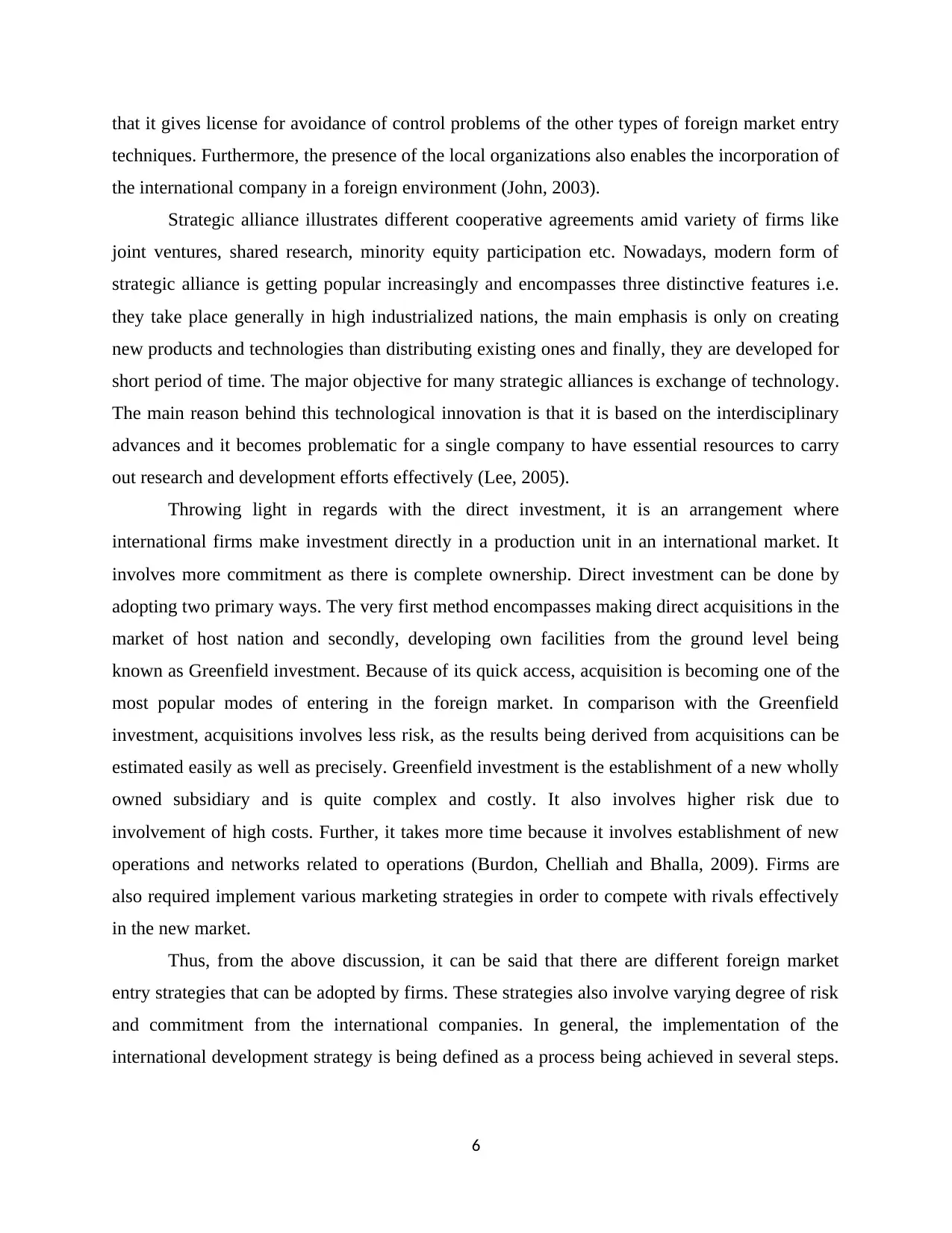
that it gives license for avoidance of control problems of the other types of foreign market entry
techniques. Furthermore, the presence of the local organizations also enables the incorporation of
the international company in a foreign environment (John, 2003).
Strategic alliance illustrates different cooperative agreements amid variety of firms like
joint ventures, shared research, minority equity participation etc. Nowadays, modern form of
strategic alliance is getting popular increasingly and encompasses three distinctive features i.e.
they take place generally in high industrialized nations, the main emphasis is only on creating
new products and technologies than distributing existing ones and finally, they are developed for
short period of time. The major objective for many strategic alliances is exchange of technology.
The main reason behind this technological innovation is that it is based on the interdisciplinary
advances and it becomes problematic for a single company to have essential resources to carry
out research and development efforts effectively (Lee, 2005).
Throwing light in regards with the direct investment, it is an arrangement where
international firms make investment directly in a production unit in an international market. It
involves more commitment as there is complete ownership. Direct investment can be done by
adopting two primary ways. The very first method encompasses making direct acquisitions in the
market of host nation and secondly, developing own facilities from the ground level being
known as Greenfield investment. Because of its quick access, acquisition is becoming one of the
most popular modes of entering in the foreign market. In comparison with the Greenfield
investment, acquisitions involves less risk, as the results being derived from acquisitions can be
estimated easily as well as precisely. Greenfield investment is the establishment of a new wholly
owned subsidiary and is quite complex and costly. It also involves higher risk due to
involvement of high costs. Further, it takes more time because it involves establishment of new
operations and networks related to operations (Burdon, Chelliah and Bhalla, 2009). Firms are
also required implement various marketing strategies in order to compete with rivals effectively
in the new market.
Thus, from the above discussion, it can be said that there are different foreign market
entry strategies that can be adopted by firms. These strategies also involve varying degree of risk
and commitment from the international companies. In general, the implementation of the
international development strategy is being defined as a process being achieved in several steps.
6
techniques. Furthermore, the presence of the local organizations also enables the incorporation of
the international company in a foreign environment (John, 2003).
Strategic alliance illustrates different cooperative agreements amid variety of firms like
joint ventures, shared research, minority equity participation etc. Nowadays, modern form of
strategic alliance is getting popular increasingly and encompasses three distinctive features i.e.
they take place generally in high industrialized nations, the main emphasis is only on creating
new products and technologies than distributing existing ones and finally, they are developed for
short period of time. The major objective for many strategic alliances is exchange of technology.
The main reason behind this technological innovation is that it is based on the interdisciplinary
advances and it becomes problematic for a single company to have essential resources to carry
out research and development efforts effectively (Lee, 2005).
Throwing light in regards with the direct investment, it is an arrangement where
international firms make investment directly in a production unit in an international market. It
involves more commitment as there is complete ownership. Direct investment can be done by
adopting two primary ways. The very first method encompasses making direct acquisitions in the
market of host nation and secondly, developing own facilities from the ground level being
known as Greenfield investment. Because of its quick access, acquisition is becoming one of the
most popular modes of entering in the foreign market. In comparison with the Greenfield
investment, acquisitions involves less risk, as the results being derived from acquisitions can be
estimated easily as well as precisely. Greenfield investment is the establishment of a new wholly
owned subsidiary and is quite complex and costly. It also involves higher risk due to
involvement of high costs. Further, it takes more time because it involves establishment of new
operations and networks related to operations (Burdon, Chelliah and Bhalla, 2009). Firms are
also required implement various marketing strategies in order to compete with rivals effectively
in the new market.
Thus, from the above discussion, it can be said that there are different foreign market
entry strategies that can be adopted by firms. These strategies also involve varying degree of risk
and commitment from the international companies. In general, the implementation of the
international development strategy is being defined as a process being achieved in several steps.
6
Paraphrase This Document
Need a fresh take? Get an instant paraphrase of this document with our AI Paraphraser
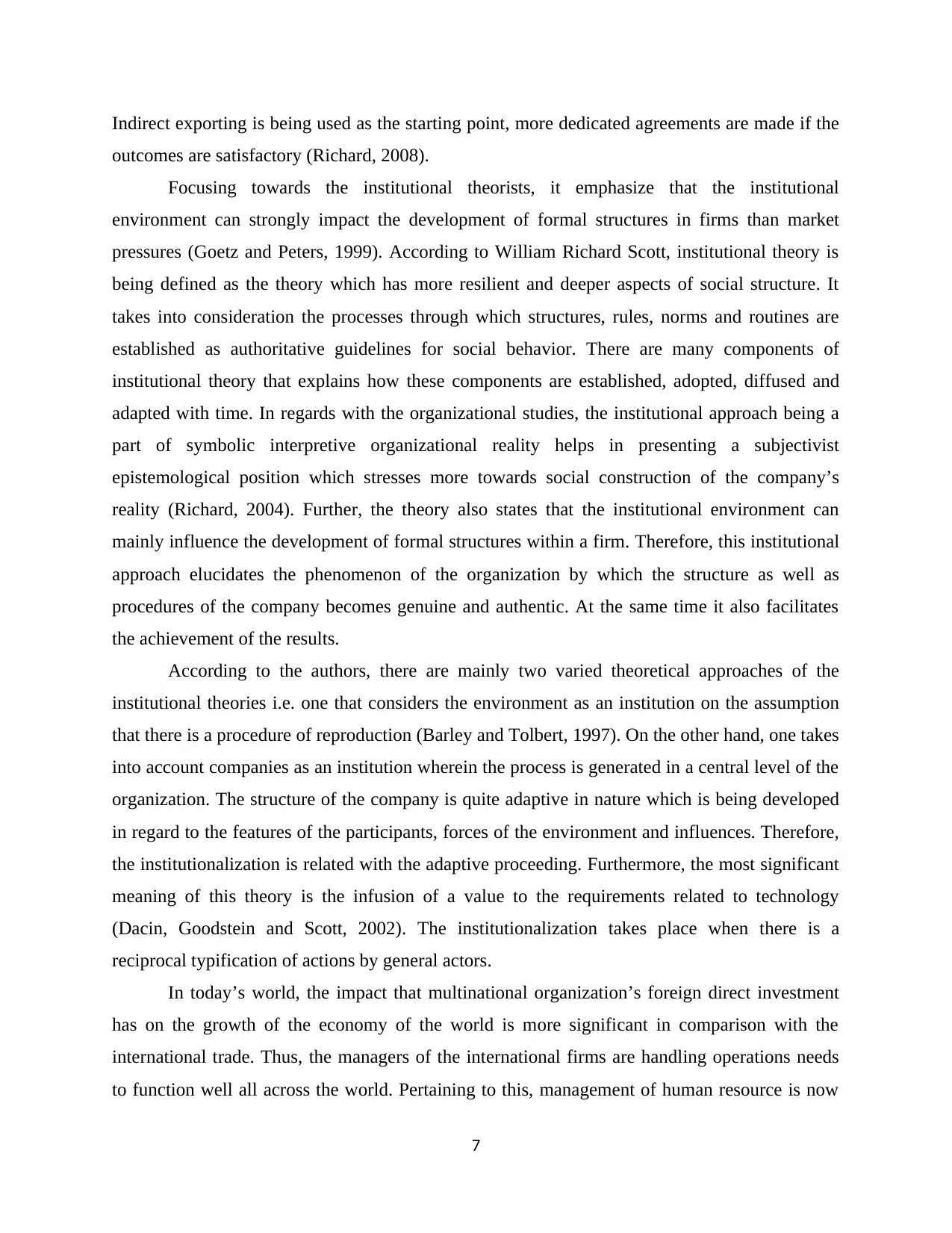
Indirect exporting is being used as the starting point, more dedicated agreements are made if the
outcomes are satisfactory (Richard, 2008).
Focusing towards the institutional theorists, it emphasize that the institutional
environment can strongly impact the development of formal structures in firms than market
pressures (Goetz and Peters, 1999). According to William Richard Scott, institutional theory is
being defined as the theory which has more resilient and deeper aspects of social structure. It
takes into consideration the processes through which structures, rules, norms and routines are
established as authoritative guidelines for social behavior. There are many components of
institutional theory that explains how these components are established, adopted, diffused and
adapted with time. In regards with the organizational studies, the institutional approach being a
part of symbolic interpretive organizational reality helps in presenting a subjectivist
epistemological position which stresses more towards social construction of the company’s
reality (Richard, 2004). Further, the theory also states that the institutional environment can
mainly influence the development of formal structures within a firm. Therefore, this institutional
approach elucidates the phenomenon of the organization by which the structure as well as
procedures of the company becomes genuine and authentic. At the same time it also facilitates
the achievement of the results.
According to the authors, there are mainly two varied theoretical approaches of the
institutional theories i.e. one that considers the environment as an institution on the assumption
that there is a procedure of reproduction (Barley and Tolbert, 1997). On the other hand, one takes
into account companies as an institution wherein the process is generated in a central level of the
organization. The structure of the company is quite adaptive in nature which is being developed
in regard to the features of the participants, forces of the environment and influences. Therefore,
the institutionalization is related with the adaptive proceeding. Furthermore, the most significant
meaning of this theory is the infusion of a value to the requirements related to technology
(Dacin, Goodstein and Scott, 2002). The institutionalization takes place when there is a
reciprocal typification of actions by general actors.
In today’s world, the impact that multinational organization’s foreign direct investment
has on the growth of the economy of the world is more significant in comparison with the
international trade. Thus, the managers of the international firms are handling operations needs
to function well all across the world. Pertaining to this, management of human resource is now
7
outcomes are satisfactory (Richard, 2008).
Focusing towards the institutional theorists, it emphasize that the institutional
environment can strongly impact the development of formal structures in firms than market
pressures (Goetz and Peters, 1999). According to William Richard Scott, institutional theory is
being defined as the theory which has more resilient and deeper aspects of social structure. It
takes into consideration the processes through which structures, rules, norms and routines are
established as authoritative guidelines for social behavior. There are many components of
institutional theory that explains how these components are established, adopted, diffused and
adapted with time. In regards with the organizational studies, the institutional approach being a
part of symbolic interpretive organizational reality helps in presenting a subjectivist
epistemological position which stresses more towards social construction of the company’s
reality (Richard, 2004). Further, the theory also states that the institutional environment can
mainly influence the development of formal structures within a firm. Therefore, this institutional
approach elucidates the phenomenon of the organization by which the structure as well as
procedures of the company becomes genuine and authentic. At the same time it also facilitates
the achievement of the results.
According to the authors, there are mainly two varied theoretical approaches of the
institutional theories i.e. one that considers the environment as an institution on the assumption
that there is a procedure of reproduction (Barley and Tolbert, 1997). On the other hand, one takes
into account companies as an institution wherein the process is generated in a central level of the
organization. The structure of the company is quite adaptive in nature which is being developed
in regard to the features of the participants, forces of the environment and influences. Therefore,
the institutionalization is related with the adaptive proceeding. Furthermore, the most significant
meaning of this theory is the infusion of a value to the requirements related to technology
(Dacin, Goodstein and Scott, 2002). The institutionalization takes place when there is a
reciprocal typification of actions by general actors.
In today’s world, the impact that multinational organization’s foreign direct investment
has on the growth of the economy of the world is more significant in comparison with the
international trade. Thus, the managers of the international firms are handling operations needs
to function well all across the world. Pertaining to this, management of human resource is now
7
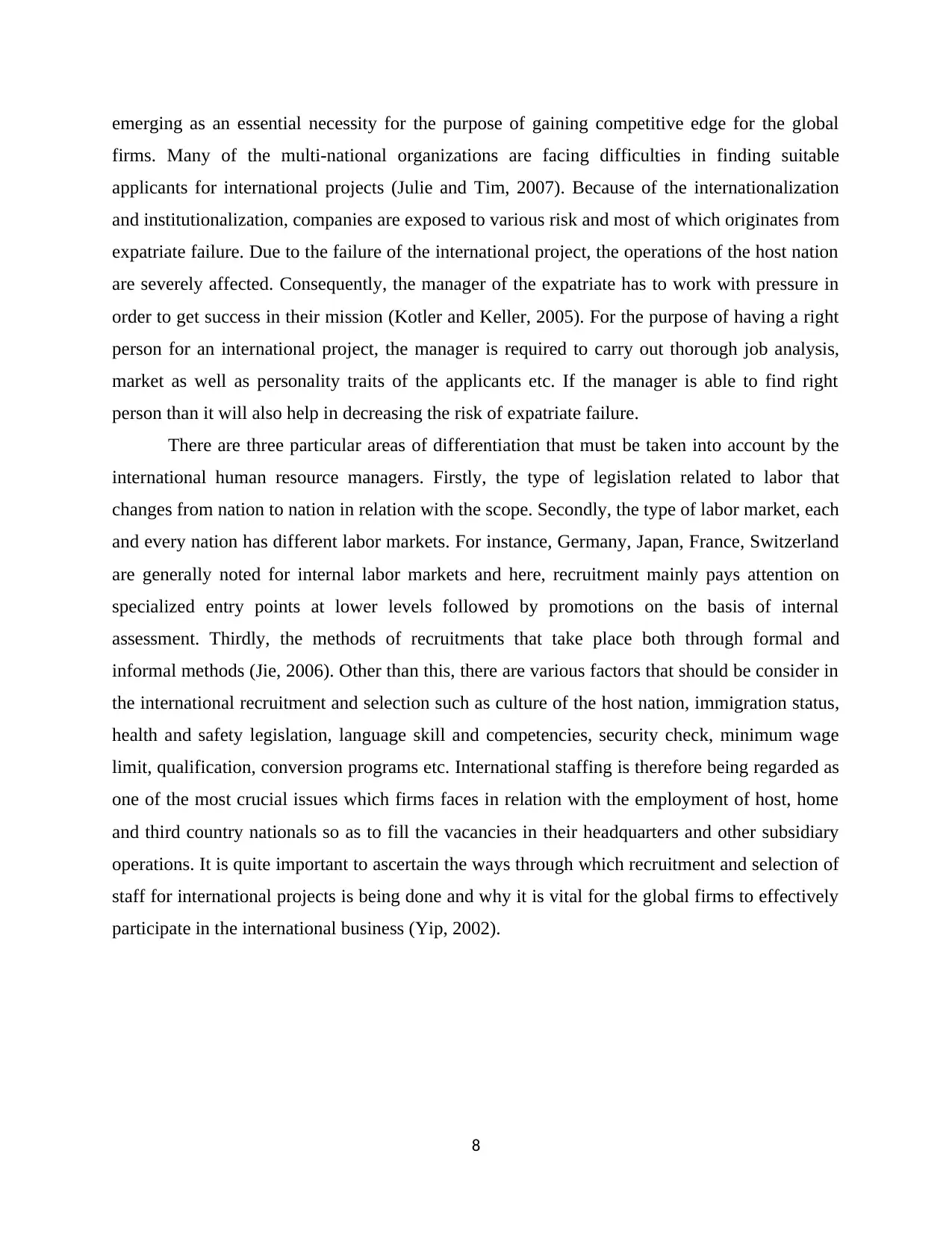
emerging as an essential necessity for the purpose of gaining competitive edge for the global
firms. Many of the multi-national organizations are facing difficulties in finding suitable
applicants for international projects (Julie and Tim, 2007). Because of the internationalization
and institutionalization, companies are exposed to various risk and most of which originates from
expatriate failure. Due to the failure of the international project, the operations of the host nation
are severely affected. Consequently, the manager of the expatriate has to work with pressure in
order to get success in their mission (Kotler and Keller, 2005). For the purpose of having a right
person for an international project, the manager is required to carry out thorough job analysis,
market as well as personality traits of the applicants etc. If the manager is able to find right
person than it will also help in decreasing the risk of expatriate failure.
There are three particular areas of differentiation that must be taken into account by the
international human resource managers. Firstly, the type of legislation related to labor that
changes from nation to nation in relation with the scope. Secondly, the type of labor market, each
and every nation has different labor markets. For instance, Germany, Japan, France, Switzerland
are generally noted for internal labor markets and here, recruitment mainly pays attention on
specialized entry points at lower levels followed by promotions on the basis of internal
assessment. Thirdly, the methods of recruitments that take place both through formal and
informal methods (Jie, 2006). Other than this, there are various factors that should be consider in
the international recruitment and selection such as culture of the host nation, immigration status,
health and safety legislation, language skill and competencies, security check, minimum wage
limit, qualification, conversion programs etc. International staffing is therefore being regarded as
one of the most crucial issues which firms faces in relation with the employment of host, home
and third country nationals so as to fill the vacancies in their headquarters and other subsidiary
operations. It is quite important to ascertain the ways through which recruitment and selection of
staff for international projects is being done and why it is vital for the global firms to effectively
participate in the international business (Yip, 2002).
8
firms. Many of the multi-national organizations are facing difficulties in finding suitable
applicants for international projects (Julie and Tim, 2007). Because of the internationalization
and institutionalization, companies are exposed to various risk and most of which originates from
expatriate failure. Due to the failure of the international project, the operations of the host nation
are severely affected. Consequently, the manager of the expatriate has to work with pressure in
order to get success in their mission (Kotler and Keller, 2005). For the purpose of having a right
person for an international project, the manager is required to carry out thorough job analysis,
market as well as personality traits of the applicants etc. If the manager is able to find right
person than it will also help in decreasing the risk of expatriate failure.
There are three particular areas of differentiation that must be taken into account by the
international human resource managers. Firstly, the type of legislation related to labor that
changes from nation to nation in relation with the scope. Secondly, the type of labor market, each
and every nation has different labor markets. For instance, Germany, Japan, France, Switzerland
are generally noted for internal labor markets and here, recruitment mainly pays attention on
specialized entry points at lower levels followed by promotions on the basis of internal
assessment. Thirdly, the methods of recruitments that take place both through formal and
informal methods (Jie, 2006). Other than this, there are various factors that should be consider in
the international recruitment and selection such as culture of the host nation, immigration status,
health and safety legislation, language skill and competencies, security check, minimum wage
limit, qualification, conversion programs etc. International staffing is therefore being regarded as
one of the most crucial issues which firms faces in relation with the employment of host, home
and third country nationals so as to fill the vacancies in their headquarters and other subsidiary
operations. It is quite important to ascertain the ways through which recruitment and selection of
staff for international projects is being done and why it is vital for the global firms to effectively
participate in the international business (Yip, 2002).
8
⊘ This is a preview!⊘
Do you want full access?
Subscribe today to unlock all pages.

Trusted by 1+ million students worldwide
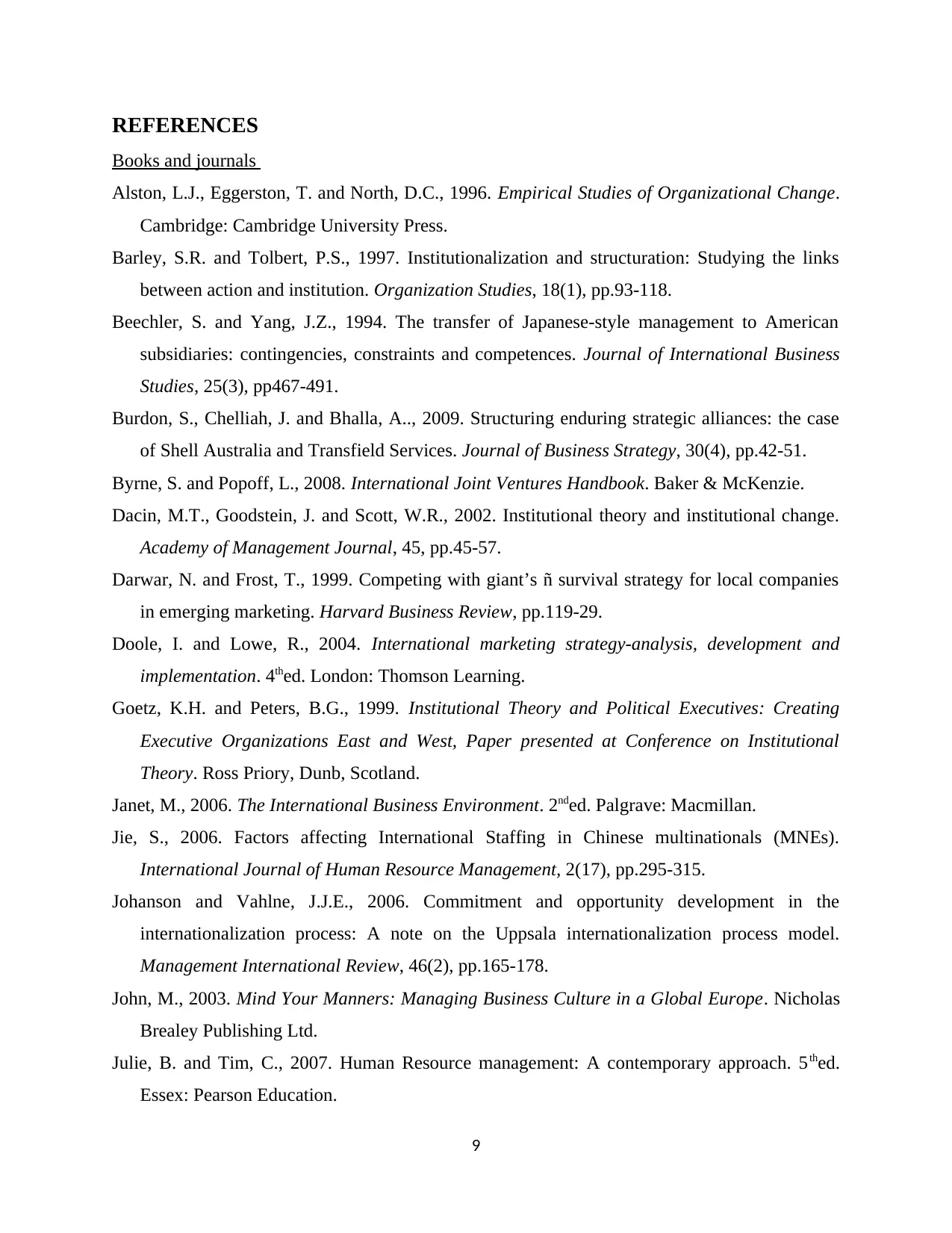
REFERENCES
Books and journals
Alston, L.J., Eggerston, T. and North, D.C., 1996. Empirical Studies of Organizational Change.
Cambridge: Cambridge University Press.
Barley, S.R. and Tolbert, P.S., 1997. Institutionalization and structuration: Studying the links
between action and institution. Organization Studies, 18(1), pp.93-118.
Beechler, S. and Yang, J.Z., 1994. The transfer of Japanese-style management to American
subsidiaries: contingencies, constraints and competences. Journal of International Business
Studies, 25(3), pp467-491.
Burdon, S., Chelliah, J. and Bhalla, A.., 2009. Structuring enduring strategic alliances: the case
of Shell Australia and Transfield Services. Journal of Business Strategy, 30(4), pp.42-51.
Byrne, S. and Popoff, L., 2008. International Joint Ventures Handbook. Baker & McKenzie.
Dacin, M.T., Goodstein, J. and Scott, W.R., 2002. Institutional theory and institutional change.
Academy of Management Journal, 45, pp.45-57.
Darwar, N. and Frost, T., 1999. Competing with giant’s ñ survival strategy for local companies
in emerging marketing. Harvard Business Review, pp.119-29.
Doole, I. and Lowe, R., 2004. International marketing strategy-analysis, development and
implementation. 4thed. London: Thomson Learning.
Goetz, K.H. and Peters, B.G., 1999. Institutional Theory and Political Executives: Creating
Executive Organizations East and West, Paper presented at Conference on Institutional
Theory. Ross Priory, Dunb, Scotland.
Janet, M., 2006. The International Business Environment. 2nded. Palgrave: Macmillan.
Jie, S., 2006. Factors affecting International Staffing in Chinese multinationals (MNEs).
International Journal of Human Resource Management, 2(17), pp.295-315.
Johanson and Vahlne, J.J.E., 2006. Commitment and opportunity development in the
internationalization process: A note on the Uppsala internationalization process model.
Management International Review, 46(2), pp.165-178.
John, M., 2003. Mind Your Manners: Managing Business Culture in a Global Europe. Nicholas
Brealey Publishing Ltd.
Julie, B. and Tim, C., 2007. Human Resource management: A contemporary approach. 5thed.
Essex: Pearson Education.
9
Books and journals
Alston, L.J., Eggerston, T. and North, D.C., 1996. Empirical Studies of Organizational Change.
Cambridge: Cambridge University Press.
Barley, S.R. and Tolbert, P.S., 1997. Institutionalization and structuration: Studying the links
between action and institution. Organization Studies, 18(1), pp.93-118.
Beechler, S. and Yang, J.Z., 1994. The transfer of Japanese-style management to American
subsidiaries: contingencies, constraints and competences. Journal of International Business
Studies, 25(3), pp467-491.
Burdon, S., Chelliah, J. and Bhalla, A.., 2009. Structuring enduring strategic alliances: the case
of Shell Australia and Transfield Services. Journal of Business Strategy, 30(4), pp.42-51.
Byrne, S. and Popoff, L., 2008. International Joint Ventures Handbook. Baker & McKenzie.
Dacin, M.T., Goodstein, J. and Scott, W.R., 2002. Institutional theory and institutional change.
Academy of Management Journal, 45, pp.45-57.
Darwar, N. and Frost, T., 1999. Competing with giant’s ñ survival strategy for local companies
in emerging marketing. Harvard Business Review, pp.119-29.
Doole, I. and Lowe, R., 2004. International marketing strategy-analysis, development and
implementation. 4thed. London: Thomson Learning.
Goetz, K.H. and Peters, B.G., 1999. Institutional Theory and Political Executives: Creating
Executive Organizations East and West, Paper presented at Conference on Institutional
Theory. Ross Priory, Dunb, Scotland.
Janet, M., 2006. The International Business Environment. 2nded. Palgrave: Macmillan.
Jie, S., 2006. Factors affecting International Staffing in Chinese multinationals (MNEs).
International Journal of Human Resource Management, 2(17), pp.295-315.
Johanson and Vahlne, J.J.E., 2006. Commitment and opportunity development in the
internationalization process: A note on the Uppsala internationalization process model.
Management International Review, 46(2), pp.165-178.
John, M., 2003. Mind Your Manners: Managing Business Culture in a Global Europe. Nicholas
Brealey Publishing Ltd.
Julie, B. and Tim, C., 2007. Human Resource management: A contemporary approach. 5thed.
Essex: Pearson Education.
9
Paraphrase This Document
Need a fresh take? Get an instant paraphrase of this document with our AI Paraphraser
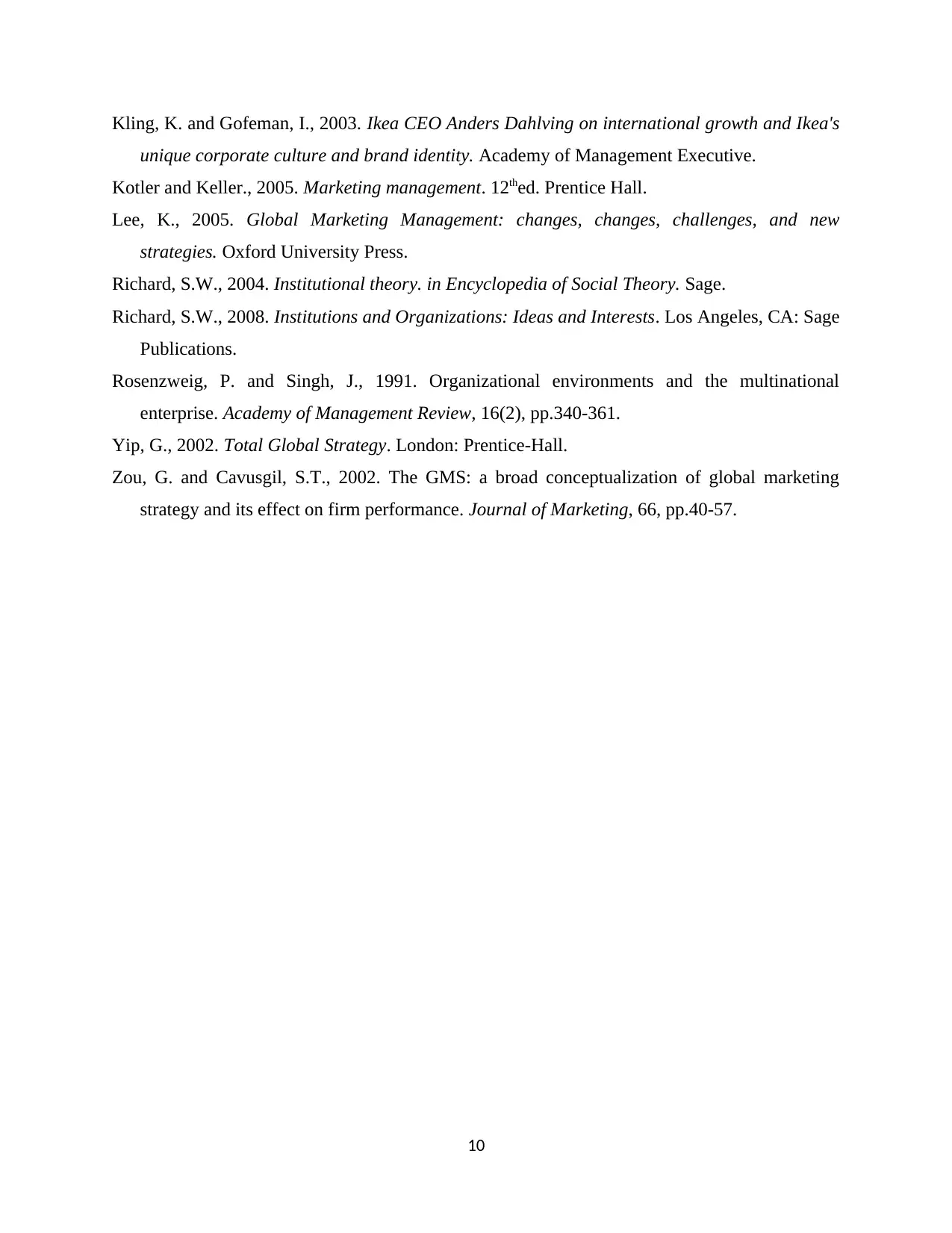
Kling, K. and Gofeman, I., 2003. Ikea CEO Anders Dahlving on international growth and Ikea's
unique corporate culture and brand identity. Academy of Management Executive.
Kotler and Keller., 2005. Marketing management. 12thed. Prentice Hall.
Lee, K., 2005. Global Marketing Management: changes, changes, challenges, and new
strategies. Oxford University Press.
Richard, S.W., 2004. Institutional theory. in Encyclopedia of Social Theory. Sage.
Richard, S.W., 2008. Institutions and Organizations: Ideas and Interests. Los Angeles, CA: Sage
Publications.
Rosenzweig, P. and Singh, J., 1991. Organizational environments and the multinational
enterprise. Academy of Management Review, 16(2), pp.340-361.
Yip, G., 2002. Total Global Strategy. London: Prentice-Hall.
Zou, G. and Cavusgil, S.T., 2002. The GMS: a broad conceptualization of global marketing
strategy and its effect on firm performance. Journal of Marketing, 66, pp.40-57.
10
unique corporate culture and brand identity. Academy of Management Executive.
Kotler and Keller., 2005. Marketing management. 12thed. Prentice Hall.
Lee, K., 2005. Global Marketing Management: changes, changes, challenges, and new
strategies. Oxford University Press.
Richard, S.W., 2004. Institutional theory. in Encyclopedia of Social Theory. Sage.
Richard, S.W., 2008. Institutions and Organizations: Ideas and Interests. Los Angeles, CA: Sage
Publications.
Rosenzweig, P. and Singh, J., 1991. Organizational environments and the multinational
enterprise. Academy of Management Review, 16(2), pp.340-361.
Yip, G., 2002. Total Global Strategy. London: Prentice-Hall.
Zou, G. and Cavusgil, S.T., 2002. The GMS: a broad conceptualization of global marketing
strategy and its effect on firm performance. Journal of Marketing, 66, pp.40-57.
10
1 out of 11
Related Documents
Your All-in-One AI-Powered Toolkit for Academic Success.
+13062052269
info@desklib.com
Available 24*7 on WhatsApp / Email
![[object Object]](/_next/static/media/star-bottom.7253800d.svg)
Unlock your academic potential
Copyright © 2020–2025 A2Z Services. All Rights Reserved. Developed and managed by ZUCOL.





